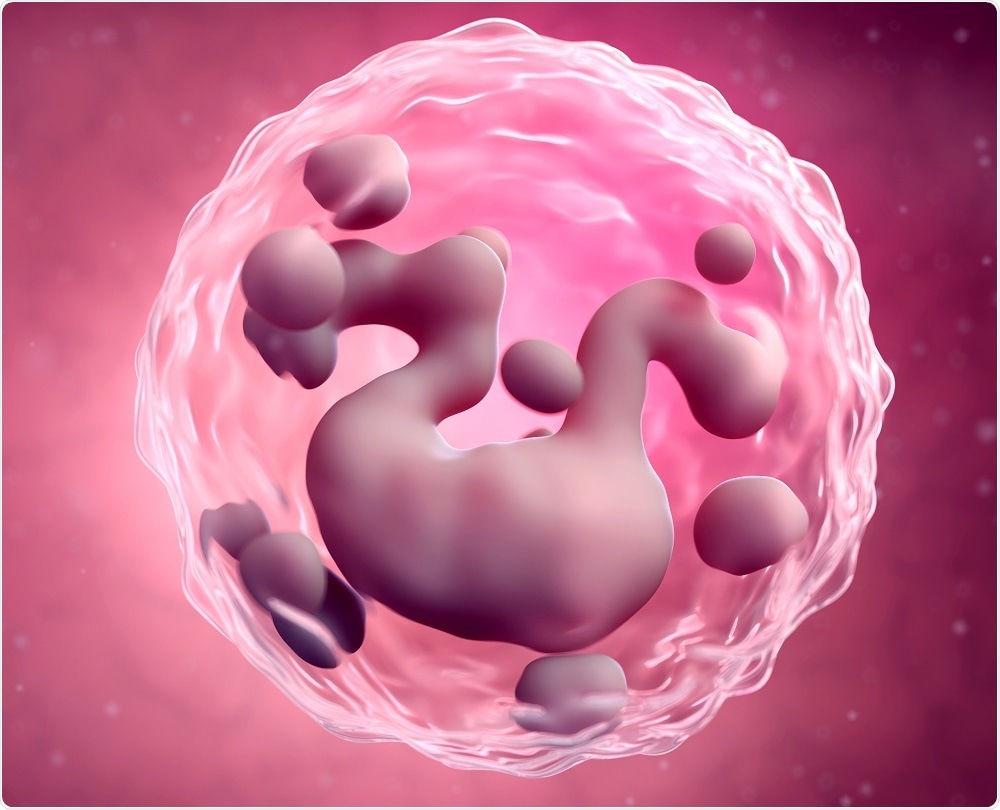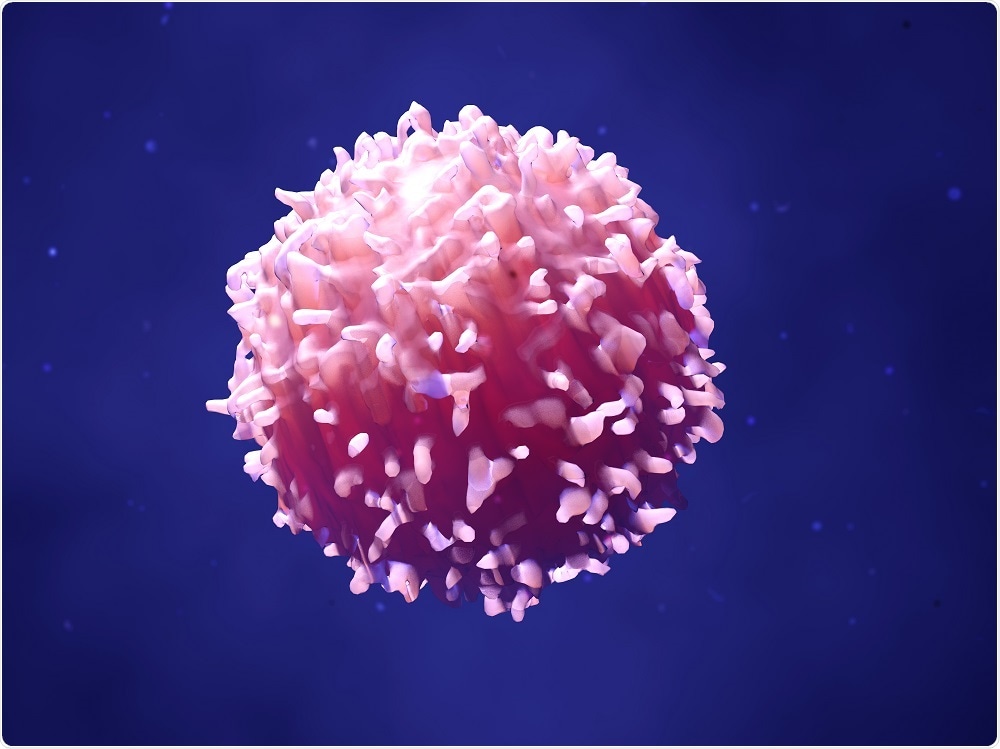An interview with Dr. Jagadeesh Bayry, DVM, PhD, conducted by Kate Anderton, BSc
What are basophils?
Basophils are a type of white blood cell (leukocyte) classified under granulocytes. They are very rare cells that represent only 0.5% of circulating leukocytes. Basophils were named due their high sensitivity to staining with basic dyes.
 Image Credit: Sebastian Kaulitzki / Shutterstock
Image Credit: Sebastian Kaulitzki / Shutterstock
Like most blood cells, basophils originate from the hematopoietic stem cells in the bone marrow. Phenotypically, these cells express FcεRI; a high-affinity receptor IgE, and CD123; a receptor for IL-3. Upon activation, they also express CD203c, CD13, CD69, CD63 and CD107a.
In human physiology, basophils play an important role in the programming of Th2 responses, and support B cell differentiation and antibody production through production of various cytokines and molecules like IL-4, IL-13, IL-6, Thymic Stromal Lymphopoietin, or TSLP, and B-cell-activating factor, or BAFF. These molecules also contribute to protection against multicellular helminth parasites.
Why is it important to study basophils and their regulators?
Basophils may be rare in number but this number does not deter them from propagating inflammation. The main reason is that basophils on their surface express diverse set of sensing receptors such as FcεRI, a high affinity receptor for IgE, cytokine receptors and pattern recognition receptors, which mediate rapid activation of basophils and hence tilt the immune homeostasis by secreting cytokines and other molecules like histamine and leukotriene.
Basophils contain huge amounts of histamine and leukotriene stored in the cytoplasmic granules. Upon cross-linking of FcεRI either through binding of allergen to surface-bound IgE or by IgE-immune complexes leads to degranulation and rapid release of histamine and leukotriene that cause hypersensitivity reactions.
Basophils are well known for their pathogenic role in asthma and allergic conditions like atopic dermatitis, urticarial and pruritic diseases. Several reports, particularly in humans, also suggest that basophils are the key mediators of inflammation in several autoimmune and inflammatory diseases such as hyper IgD syndrome and eosinophilic oesophagitis.
Additionally, experimental models suggest that basophils have a pathogenic role in the lupus and inflammatory bowel disease. Thus, given their pathogenic role in many diseases, investigating the basophil biology and the players that keep basophil activation and function under tight control is important.
Please describe your recent research in the field of immunology.
The research conducted by our team is focused upon investigating the mechanisms by which regulatory T cells (Tregs), B cells and circulating immunoglobulins (IgG, IgA and IgM) maintain immune homeostasis, and how we can exploit this fundamental knowledge in translational research.
Our recent study led to unravelling of novel mechanisms by which Tregs, B cells and their products, the immunoglobulins, accomplish immune homeostasis by regulating the dendritic cell and basophil functions, and T cell polarization.
These fundamental discoveries were subsequently exploited for translational purposes wherein we provided a “proof of principle” for the efficient targeting of Tregs (without their depletion rather transiently inhibiting their negative influence on the immune system) by small molecule antagonists to CCR4 that exhibited ‘adjuvant’ like properties to enhance immune response to the vaccines.
We also proved the ability of normal immunoglobulin G (a pooled normal IgG preparation obtained from the plasma of several thousand healthy donors) to reciprocally regulate pathogenic Th17 and Tregs in autoimmune conditions. This provides translational insight and therapeutic utility of circulating normal immunoglobulins in establishing immune tolerance.
Why did you choose to study regulatory T cells?
There are several players implicated in the regulation of immune homeostasis and prevention of inflammation. Among these players, CD4+CD25+FoxP3+ regulatory T cells (Tregs) are of special importance and are well characterized.
 Image Credit: Design_Cells / Shutterstock
Image Credit: Design_Cells / Shutterstock
A deficiency of Tregs in experimental models results in either the appearance or exacerbation of autoimmune disease, whereas adoptive transfer of Tregs either before or during early phase of induction of autoimmune disease cures the disease.
In humans, deficiency of Tregs due to mutations in FoxP3 leads to IPEX (immune dysregulation, polyendocrinopathy, enteropathy, X-linked) syndrome and is a severe autoimmune inflammatory disorder.
Tregs maintain immune tolerance and ensure autoimmune and inflammatory disease-free state of an individual by suppressing the activation of both innate and adaptive immune cells including dendritic cells, macrophages, monocytes, neutrophils, mast cells, natural killer cells, T and B cells.
Tregs are also exploited in the treatment of patients with autoimmune and inflammatory diseases either by adoptive cell transfer or through the use of Treg-based molecules like CTLA-4.
Despite basophils are pathogenic in many diseases, the mechanisms that regulate basophil functions are not yet known. Therefore, we investigated the cross-talk between basophils and Tregs with an hypothesis that Tregs might suppress the basophil activation.
What impact will this research have on the study of human disease?
In my opinion, these basic findings have broad consequences in the therapy and management of allergic diseases. Numerous therapeutic strategies are under preclinical development for allergic diseases. These strategies mainly aim at boosting the functions and/or number of Tregs.
As Tregs can activate the basophils and sensitize them to IgE-mediated degranulation process leading to the release molecules of hypersensitivity reactions, our data imply that immunotherapies aimed at only Tregs axis might not provide satisfactory results. Hence, we will need to incorporate strategies that target basophils as well for the development of efficient treatments.
Where can readers find more information?
Sharma M, Das M, Stephen-Victor E, Galeotti C, Karnam A, Maddur MS, Bruneval P, Kaveri SV, Bayry J. Regulatory T cells induce activation rather than suppression of human basophils. Sci Immunol. 2018 May 25;3(23).
About Dr. Jagadeesh Bayry
 Dr. Jagadeesh Bayry is a principal investigator at Institut National de la Santé et de la Recherche Médicale (French National Institute of Health and Medical Research, INSERM), Paris, France.
Dr. Jagadeesh Bayry is a principal investigator at Institut National de la Santé et de la Recherche Médicale (French National Institute of Health and Medical Research, INSERM), Paris, France.
He obtained PhD in immunology at the Université Pierre et Marie Curie (Sorbonne University), Paris in 2003. Following post-doctoral research at University of Oxford, he joined INSERM as a Scientist in 2006.
Dr. Bayry has authored over 200 articles and is an Associate Editor of Scientific Reports, Frontiers in Immunology, PLoS ONE, Mediators of Inflammation and Journal of Immunology Research, and Editorial Board Member of several other journals.
His research is aimed at investigating the cellular and molecular mechanisms of maintenance of immune homeostasis by regulatory T cells, B cells and immunoglobulins; and deciphering host-pathogen interactions.